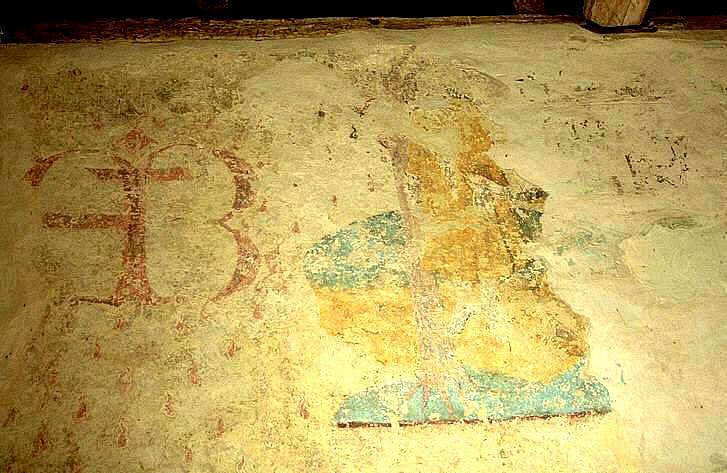Breamore, Hampshire (†Winchester) C.15?
The Suicide of Judas
‘To slay myself now will I speed, For sadly have I served to ill…’ Judas¹

The painting is in the south porch, on the western wall. The Saxon Rood, with its painted landscape background, is above the south door. The colours suggest that this painting is of the same date as that background. Establishing that date is not easy, given the faded and fragmented condition of both, but I doubt if it is much earlier than about 1400. Not much remains of the figure of Judas, but his unusually short yellow robe and dangling bare feet are detectable to the right of the light brown trunk of the tree, with its exposed roots. He may have the bag of money hanging around his neck or at his side on the right. His stocky, solid figure and squarish ‘realistic’ feet, along with the exposed roots of the tree and perhaps also the hiked-up robe as the painter tries to cater for the onlooker’s low viewpoint, all suggest a late date, to my mind. I think the painting is 15th century; the Suicide of Judas at Slapton in Northamptonshire dates from around that time, although the example of the subject in the Passion Cycle at Gussage St Andrew in Dorset was painted in the 13th century.
Whenever the painting was made, it was obviously thought to be a suitable companion piece to the early Rood and its background above the South Door. There was painting on the opposite porch wall (the east) as well, but what remains of it is now completely obscure.
The suicide of Judas is not Biblical – Acts 1:18-19 describes his end – but Judas announces his suicidal intentions in the York Mystery Cycle (Cooks & Water – Leaders Play) quoted above, and his self-hanging came into art generally from the late Middle Ages/Early Renaissance. One of the characters in Christopher Marlowe’s Jew of Malta (1589/90) says scornfully of his villainous master that ‘the hat he wears, Judas left under the elder when he hanged himself’² – by this time the suicide had obviously become an accepted part of the Judas story.
The large red ochre ‘M’ (for Mary) monogram on the left is probably 15th century, perhaps a bit later than the Judas painting. The remarkable Anglo-Saxon inscription at Breamore is also on these pages.
Website for St Mary’s, Breamore
¹The Cukes & Waterleders Play, The York Cycle of Mystery Plays, ed. JD Purvis, 1957 (SPCK) p.256
²The Plays of Christopher Marlowe, ed. R.Gill, Oxford, 1971, p. 241